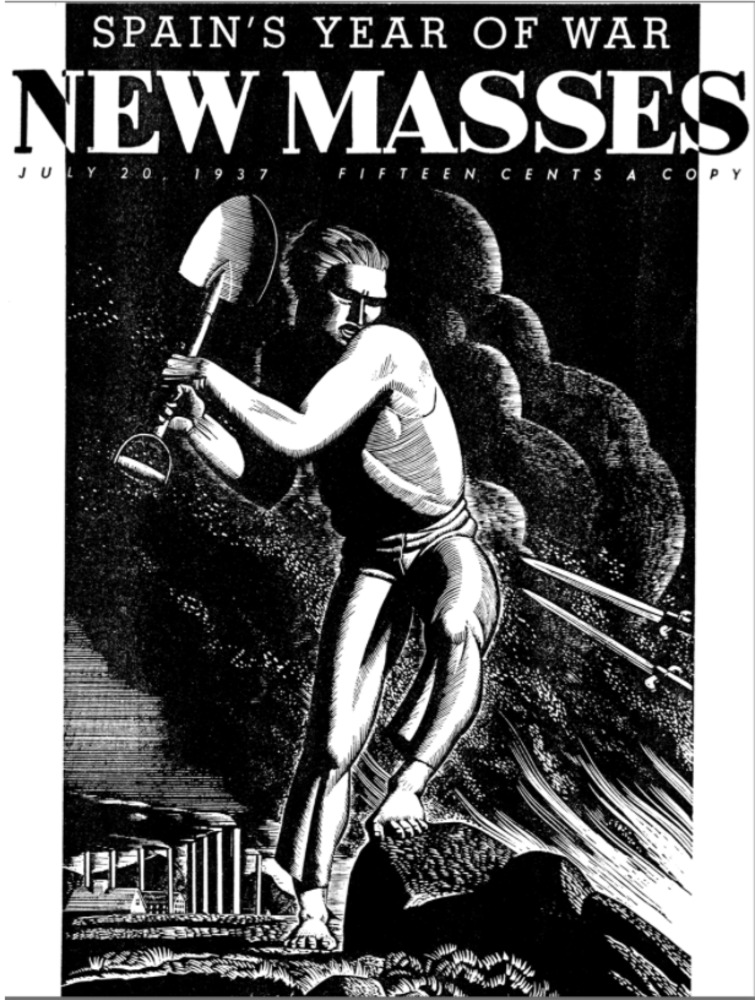Workers of the World, Unite!
Kent's Pivotal Contribution to The New Masses
The New Masses in 1937 Leftist Thought
Workers of the World, Unite! was published in a July 1937 issue of the New Masses. America was facing a depression, and both fascist and leftist movements were on the rise. According to Foley’s Radical Representations: Politics and Form in U.S. Proletarian Fiction, 1929–1941, the 1930s “literary left”, the body of leftist artists and writers who created “proletarian literature”, was divided into opposing schools of thought that disagreed about the best approach to revolutionary art. Some Marxists argued that all art was political propaganda, while often approaching their own work as depoliticized. Many were firm in their belief that proletarian art should not explicitly contain articulations of leftist theories and worldviews, but should present the audience with realistic depictions of a world in which workers’ solidarity is a practical and workable solution. Partisan Review, another leftist magazine, criticized the New Masses for being “crudely didactic” in their approach to political messaging (Foley). The issue of the Masses that Kent illustrated featured articles titled Spain After a Year of War, Antagonism or Harmony Between Marx and Freud?, and A Socialist on the People's Front, reflecting a broad range of topics that sought to inform its audience and maintain a leftist viewpoint.
The Messaging of Kent’s Cover
In Workers of the World, Unite!, Kent explores themes of industrialism and anti-labor forces, while positioning an idealized figure of a worker as more powerful than the forces of industrial domination. The figure, wearing an intense expression and worker’s clothes blown against his muscular body, raises a shovel, preparing to swing it powerfully down towards the lower right corner of the image. The figure is strong, capable, and action-oriented: all virtues that the workers would need to secure their rights against profit-driven institutions. Parallel hatching and shining light reflecting on the figure change the texture of fabric and skin to something metallic, unbreakable, and powerful as steel or machinery. This anchors the figure in a conversation about mechanization and the role of labor in the industrial age, and portrays human strength as at least equal to machine strength. This positions the figure as literally above the forces that threaten him. Smokestacks in the background reinforce this theme, reminding the viewer of the exploitation and hazardous conditions common to factories of the time. This would have reminded viewers at the time of miners' and other strikes, sites of violence and struggle. The night landscape, with only grass, rocks, and an unspecified factory belching smoke in the background, is positioned to be general, not specific, which strengthens the illustrator's message of universality: these elements represent the forces of large industry and the means by which they fight the labor movement.
The other elements of the illustration almost match the figure in directional force, though not in overall visual strength. A strong leftward wind, opposing the worker's rightward strike, is visible in the movement of the smoke, fire, and sparks, and this horizontal force is emphasized by the background's many thin horizontal lines. The opposing elements are also, in their repetition, allied against the worker: the vertical lines of the smokestacks reinforce each other, the clouds of smoke repeat their heavy curves, and even the blades are paired. The diagonal forces of the blades and flames may be pushing the worker slightly away, but it is apparent from the worker's visible muscle and size that his oncoming strike will overpower them.
Part of 1 Learning Collection
<p>An In-Depth Explanation of Kent and His Beliefs<...
<p>Rockwell Kent's Unique Techniques Visualized in ...
<p>A Deeper Dive into Kent's works for the <i>New M...
<p>A Deeper Dive into the Beginning and End of the ...
Created For
K-12 EducatorK-12 Student
Museum Visitor
UMMA Docent
UMMA Staff
University Faculty
University Student
Rate this Resource
AVG: 0 | Ratings: 0
& Author Notes
All Rights ReservedLast Updated
December 2, 2023 7:02 p.m.Report
Reporting Policy

